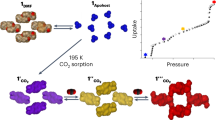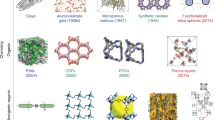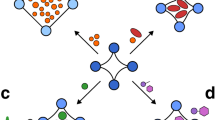Abstract
The ultrahigh porosity and varied functionalities of porous metal–organic frameworks make them excellent candidates for applications that range widely from gas storage and separation to catalysis and sensing. An interesting feature of some frameworks is the ability to open their pores to a specific guest, enabling highly selective separation. A prerequisite for this is bistability of the host structure, which enables the framework to breathe, that is, to switch between two stability minima in response to its environment. Here we describe a porous framework DUT-8(Ni)—which consists of nickel paddle wheel clusters and carboxylate linkers—that adopts a configurationally degenerate family of disordered states in the presence of specific guests. This disorder originates from the nonlinear linkers arranging the clusters in closed loops of different local symmetries that in turn propagate as complex tilings. Solvent exchange stimulates the formation of distinct disordered frameworks, as demonstrated by high-resolution transmission electron microscopy and diffraction techniques. Guest exchange was shown to stimulate repeatable switching transitions between distinct disorder states.

This is a preview of subscription content, access via your institution
Access options
Access Nature and 54 other Nature Portfolio journals
Get Nature+, our best-value online-access subscription
$29.99 / 30 days
cancel any time
Subscribe to this journal
Receive 12 print issues and online access
$259.00 per year
only $21.58 per issue
Buy this article
- Purchase on Springer Link
- Instant access to full article PDF
Prices may be subject to local taxes which are calculated during checkout





Similar content being viewed by others
Data availability
The data supporting the findings of this study are available within the article and its Supplementary Information. The corresponding raw data are available from the corresponding authors. Crystallographic data for the single-crystal structures can be obtained free of charge from the Cambridge Crystallographic Data Centre via www.ccdc.cam.ac.uk/data_request/cif, under the deposition nos. CCDC-1989709 (DMF@DUT-8(Ni), polymorph A); CCDC-1989708 (DMF@DUT-8(Ni), polymorph B); CCDC-1989557 (NMP@DUT-8(Ni), single domain); CCDC-1989558 (NMP@DUT-8(Ni), four-component twin); CCDC-1989559 (toluene@DUT-8(Ni), single domain) and CCDC-1989560 (toluene@DUT-8(Ni), four-component twin). For each solvent, further details about the two independent refinements considering a single domain crystal and a four-component twin are explained in the Methods and Supplementary Information.
Code availability
All custom code used for the disorder analysis in this study was developed using widely available algorithms. Copies of the actual code used can be obtained on request from A.L.G. Computational data supporting the findings in Supplementary Section 10 are available from the public GitHub online repository at https://github.com/jackevansadl/supp-data.
References
Hönicke, I. M. et al. Balancing mechanical stability and ultrahigh porosity in crystalline framework materials. Angew. Chem. Int. Ed. 57, 13780–13783 (2018).
Maurin, G., Serre, C., Cooper, A. & Ferey, G. The new age of MOFs and of their porous-related solids. Chem. Soc. Rev. 46, 3104–3107 (2017).
Huang, Y.-B., Liang, J., Wang, X.-S. & Cao, R. Multifunctional metal–organic framework catalysts: synergistic catalysis and tandem reactions. Chem. Soc. Rev. 46, 126–157 (2017).
Zhou, H.-C., Long, J. R. & Yaghi, O. M. Introduction to metal–organic frameworks. Chem. Rev. 112, 673–674 (2012).
Stock, N. & Biswas, S. Synthesis of metal–organic frameworks (MOFs): routes to various MOF topologies, morphologies, and composites. Chem. Rev. 112, 933–969 (2011).
Caro, J. Quo vadis, MOF? Chem. Ing. Tech. 90, 1759–1768 (2018).
Fathieh, F. et al. Practical water production from desert air. Sci. Adv. 4, eaat3198 (2018).
Chen, Y. et al. Stabilization of formate dehydrogenase in a metal–organic framework for bioelectrocatalytic reduction of CO2. Angew. Chem. Int. Ed. 131, 7764–7768 (2019).
Schneemann, A. et al. Flexible metal–organic frameworks. Chem. Soc. Rev. 43, 6062–6096 (2014).
Lee, J. H., Jeoung, S., Chung, Y. G. & Moon, H. R. Elucidation of flexible metal–organic frameworks: research progresses and recent developments. Coord. Chem. Rev. 389, 161–188 (2019).
Yang, S. et al. A partially interpenetrated metal–organic framework for selective hysteretic sorption of carbon dioxide. Nat. Mater. 11, 710–716 (2012).
Duan, J. et al. High CO2/N2/O2/CO separation in a chemically robust porous coordination polymer with low binding energy. Chem. Sci. 5, 660–666 (2014).
Li, L. et al. Efficient separation of ethylene from acetylene/ethylene mixtures by a flexible-robust metal–organic framework. J. Mater. Chem. A 5, 18984–18988 (2017).
Taylor, M. K. et al. Near-perfect CO2/CH4 selectivity achieved through reversible guest templating in the flexible metal–organic framework Co(bdp). J. Am. Chem. Soc. 140, 10324–10331 (2018).
Mason, J. A. et al. Methane storage in flexible metal–organic frameworks with intrinsic thermal management. Nature 527, 357–361 (2015).
Li, H. et al. Recent advances in gas storage and separation using metal–organic frameworks. Mater. Today 21, 108–121 (2018).
Kundu, T., Wahiduzzaman, M., Bhuvan, B. S., Maurin, G. & Zhao, D. Solvent‐induced control over breathing behavior in flexible metal–organic frameworks for natural‐gas delivery. Angew. Chem. Int. Ed. 58, 8073–8077 (2019).
Katsoulidis, A. P. et al. Chemical control of structure and guest uptake by a conformationally mobile porous material. Nature 565, 213–217 (2019).
Serre, C. et al. Very large breathing effect in the first nanoporous chromium(iii)-based solids: MIL-53 or Criii(OH){O2C−C6H4−CO2}{HO2C−C6H4−CO2H}xH2Oy. J. Am. Chem. Soc. 124, 13519–13526 (2002).
Krause, S. et al. A pressure-amplifying framework material with negative gas adsorption transitions. Nature 532, 348–352 (2016).
Krause, S. et al. Towards general network architecture design criteria for negative gas adsorption transitions in ultraporous frameworks. Nat. Commun. 10, 3632 (2019).
Serre, C. et al. Role of solvent–host interactions that lead to very large swelling of hybrid frameworks. Science 315, 1828–1831 (2007).
Dybtsev, D. N., Chun, H. & Kim, K. Rigid and flexible: a highly porous metal–organic framework with unusual guest‐dependent dynamic behavior. Angew. Chem. Int. Ed. 43, 5033–5036 (2004).
Bon, V. et al. Exceptional adsorption-induced cluster and network deformation in the flexible metal–organic framework DUT-8(Ni) observed by in situ X-ray diffraction and EXAFS. Phys. Chem. Chem. Phys. 17, 17471–17479 (2015).
Klein, N. et al. Monitoring adsorption-induced switching by 129Xe NMR spectroscopy in a new metal–organic framework Ni2(2,6-ndc)2(dabco). Phys. Chem. Chem. Phys. 12, 11778–11784 (2010).
Klein, N. et al. Structural flexibility and intrinsic dynamics in the M2(2,6-ndc)2(dabco)(M = Ni, Cu, Co, Zn) metal–organic frameworks. J. Mater. Chem. 22, 10303–10312 (2012).
Ehrling, S. et al. Crystal size versus paddle wheel deformability: selective gated adsorption transitions of the switchable metal–organic frameworks DUT-8(Co) and DUT-8(Ni). J. Mater. Chem. A 7, 21459–21475 (2019).
Kavoosi, N. et al. Tailoring adsorption induced phase transitions in the pillared-layer type metal–organic framework DUT-8(Ni). Dalton Trans. 46, 4685–4695 (2017).
Miura, H. et al. Tuning the gate-opening pressure and particle size distribution of the switchable metal–organic framework DUT-8(Ni) by controlled nucleation in a micromixer. Dalton Trans. 46, 14002–14011 (2017).
Kavoosi, N. et al. Selective pore opening and gating of the pillared layer metal–organic framework DUT-8(Ni) upon liquid phase multi-component adsorption. Micropor. Mesopor. Mater. 271, 169–174 (2018).
Rauche, M. et al. New insights into solvent-induced structural changes of 13C labelled metal–organic frameworks by solid state NMR. Chem. Commun. 55, 9140–9143 (2019).
Petkov, P. S. et al. Conformational isomerism controls collective flexibility in metal–organic framework DUT-8(Ni). Phys. Chem. Chem. Phys. 21, 674–680 (2019).
Lieb, E. H. Residual entropy of square ice. Phys. Rev. 162, 162 (1967).
Carrington, E. J. et al. Solvent-switchable continuous-breathing behaviour in a diamondoid metal–organic framework and its influence on CO2 versus CH4 selectivity. Nat. Chem. 9, 882–889 (2017).
Sakata, Y. et al. Shape-memory nanopores induced in coordination frameworks by crystal downsizing. Science 339, 193–196 (2013).
Smallwood, I. Handbook of Organic Solvent Properties (Butterworth-Heinemann, 2012).
Krause, S. et al. The effect of crystallite size on pressure amplification in switchable porous solids. Nat. Commun. 9, 1573 (2018).
Kolbe, F. et al. High pressure in situ 129Xe NMR spectroscopy: insights into switching mechanisms of flexible metal–organic frameworks isoreticular to DUT-49. Chem. Mater. 31, 6193–6201 (2019).
Yuan, S. et al. Flexible zirconium metal‐organic frameworks as bioinspired switchable catalysts. Angew. Chem. Int. Ed. 55, 10776–10780 (2016).
Evans, J. D., Bon, V., Senkovska, I., Lee, H.-C. & Kaskel, S. Four-dimensional metal–organic frameworks. Nat. Commun. 11, 2690 (2020).
Barnes, R., Torgeson, D. R. & Bray, P. J. On NMR powder spectrum simulation for nuclei with I > 1/2. Phys. Status Solidi B 147, K175–K178 (1988).
Schmidt-Rohr, K. & Spiess, H. W. Multidimensional Solid-state NMR and Polymers (Elsevier, 2012).
Spiess, H. W. Molecular dynamics of solid polymers as revealed by deuteron NMR. Colloid Polym. Sci. 261, 193–209 (1983).
Spiess, H. W. & Sillescu, H. Solid echoes in the slow-motion region. J. Magn. Reson. 42, 381–389 (1981).
O’Dell, L. A. & Schurko, R. W. QCPMG using adiabatic pulses for faster acquisition of ultra-wideline NMR spectra. Chem. Phys. Lett. 464, 97–102 (2008).
Duer, M. J. Introduction to Solid-state NMR Spectroscopy (Wiley-Blackwell, 2005).
Simonov, A. & Goodwin, A. L. Designing disorder into crystalline materials. Nat. Rev. Chem. 4, 657–673 (2020).
Macho, V., Brombacher, L., Graf, R. & Spiess, H. W. NMR Weblab (Max Planck Institute for Polymer Research Mainz, 2018); https://weblab2.mpip-mainz.mpg.de/weblab66/
Nagle, J. Theory of the dielectric constant of ice. Chem. Phys. 43, 317–328 (1979).
Sheldrick, G. M. Crystal structure refinement with SHELXL. Acta Cryst. C. 71, 3–8 (2015).
Gerlach, M. et al. The MX beamlines BL14.1-3 at BESSY II. JLSRF 2, A47 (2016).
Sparta, K. M. et al. XDSAPP2.0. J. Appl. Cryst. 49, 1085–1092 (2016).
CELL_NOW v.2008/4 (Bruker AXS Inc., 2008).
SAINT v.8.34A (Bruker AXS Inc., 2012).
TWINABS v.2012/1 (Bruker AXS Inc., 2012).
Barkema, G. & Newman, M. Monte Carlo simulation of ice models. Phys. Rev. E 57, 1155 (1998).
Palmer, D. C. Visualization and analysis of crystal structures using CrystalMaker software. Z. Kristallogr. 230, 559–572 (2015).
Schmidt, E. & Neder, R. B. Diffuse single‐crystal scattering corrected for molecular form factor effects. Acta Cryst. A. 73, 231–237 (2017).
Kohl, H. & Reimer, L. Transmission Electron Microscopy: Physics of Image Formation (Springer, 2008).
Oleynikov, P. eMap and eSlice: a software package for crystallographic computing. Cryst. Res. Technol. 46, 569–579 (2011).
Acknowledgements
We thank the German Science Foundation (DFG) (FOR2433) for financial support. We thank HZB for allocation of the synchrotron radiation beamtime and financial support. V.B. thanks the BMBF (project no. 05K19OD2) for financial support. T.E.G. is grateful to DFG for financial support (project CRC 1279). J.D.E. acknowledges the support of the Alexander von Humboldt foundation and HPC platforms provided by the Center for Information Services and High-Performance Computing (ZIH) at TU Dresden. A.L.G. gratefully acknowledges the European Research Council for financial support (advanced grant no. 788144). This project received funding from the European Union (EU) Horizon 2020 Research and an Innovation Programme under Marie Sklodowska-Curie grant agreement no. 641887 (project acronym DEFNET).
Author information
Authors and Affiliations
Contributions
S.E. and V.B. synthesized and characterized all materials by X-ray diffraction. M.S.W. supported the collection of single crystal X-ray data. E.R. and A.L.G. developed the disorder models. I.S., T.E.G. and U.K. analysed the domain structure of nanocrystals using TEM and electron diffraction data. J.D.E. performed molecular simulations. M.R. and E.B. performed and interpreted the 2H NMR spectra. M.M. and A.P. measured and interpreted the EPR spectra. A.L.G. and S.K. initiated and scientifically guided the study. All authors contributed to writing and improving the manuscript.
Corresponding authors
Ethics declarations
Competing interests
The authors declare no competing interests.
Additional information
Peer review information Nature Chemistry thanks Richard Catlow, João Rocha, Christian Serre and the other, anonymous, reviewer(s) for their contribution to the peer review of this work.
Publisher’s note Springer Nature remains neutral with regard to jurisdictional claims in published maps and institutional affiliations.
Extended data
Extended Data Fig. 1 Illustration of the tile symbols.
a, Representation of type 1 (C2h) and type 2 (D2d) loops satisfying the registry requirement for closed loops by arrows indicating up and down steps of the 2,6-ndc linker. b, Transformation of the 6 loops into colour-coded tiles. c, Representative transformation scheme of one loop from arrow scheme to a tile with tongue and groove.
Extended Data Fig. 2 Tiling of the two ordered polymorphs.
Polymorphs A and B represent only two limiting, ordered instances made of pure D2d or C2h tilings, respectively, within a much larger configurational landscape.
Extended Data Fig. 3 Illustration of disorder variants and the corresponding local paddle wheel symmetry.
a, Variation of the probability ϕ for a 5x5 superstructure in 3 representative disorder configurations only containing type 1 (C2h) loops. b, Representation of local paddle wheel variants.
Extended Data Fig. 4 Illustration of the formation of microdomains.
Representative 16x16 superstructure containing C2h and D2d loops.
Extended Data Fig. 5 Entire configurational space of potential and experimentally observed disorder variants.
a, Localization of disorder configurations in ϕ−η space. Each coloured tiling illustrates a guest-specific characteristic disordered state. b, Lateral view of a representative disorder configuration.
Extended Data Fig. 6 Single crystal X-ray observations for ‘as made’ DUT-8(Ni).
Representation of (hk0), (hk1), (hk2) and (hk3) reciprocal lattice planes of DMF@DUT-8(Ni), indicating the presence of both monoclinic (type 1, C2h) and tetragonal (type 2, D2d) domains in the structure.
Extended Data Fig. 7 Single crystal X-ray observations for solvent exchanged DUT-8(Ni).
a, Representation of (hk0), (hk1) and (hk2) reciprocal planes for NMP@DUT-8(Ni). b, Reciprocal planes of toluene@DUT-8(Ni).
Extended Data Fig. 8 Electron diffraction data.
a, Kinematically simulated electron diffraction patterns of tetragonal phase of DUT-8(Ni) along [110] zone. b, Simulated EDF patterns along [331] zone. c, Experimental electron diffraction pattern of as made DUT-8(Ni).
Extended Data Fig. 9 Simulated NMR spectra.
The shape of 2H NMR spectra was modelled for various scenarios differing in linker dynamics.
Supplementary information
Supplementary Information
Supplementary Figs. 1–17, Sections 1–10 and Tables 1–9.
Supplementary Data 1
CCDC-1989709 contains the supplementary crystallographic data for DMF solvated DUT-8(Ni) refined as polymorph A.
Supplementary Data 2
CCDC-1989708 contains the supplementary crystallographic data for DMF solvated DUT-8(Ni) refined as polymorph B.
Supplementary Data 3
CCDC-1989557 contains the supplementary crystallographic data for NMP solvated DUT-8(Ni) refined as a single-domain crystal.
Supplementary Data 4
CCDC-1989558 contains the supplementary crystallographic data for NMP solvated DUT-8(Ni) refined as a four-component twin.
Supplementary Data 5
CCDC-1989559 contains the supplementary crystallographic data for toluene solvated DUT-8(Ni) refined as a single domain crystal.
Supplementary Data 6
CCDC-1989560 contains the supplementary crystallographic data for toluene solvated DUT-8(Ni) refined as a four-component twin.
Supplementary Data 7
Source data for the Supplementary Figs. 15 and 17.
Supplementary Data 8
Results from [CREST] (https://xtb-docs.readthedocs.io/en/latest/crestversions.html) analysis of the PW cluster present in the DUT-8 framework and interactions with solvent molecules. -[mono_dcm](mono_dcm): Monolinic symmetry with DCM molecules. -[mono_dmf](mono_dmf): Monolinic symmetry with DMF molecules. -[tetra_dcm](tetra_dcm): tetragonal symmetry with DCM molecules. -[tetra_dmf](tetra_dmf): tetragonal symmetry with DMF molecules.
Rights and permissions
About this article
Cite this article
Ehrling, S., Reynolds, E.M., Bon, V. et al. Adaptive response of a metal–organic framework through reversible disorder–disorder transitions. Nat. Chem. 13, 568–574 (2021). https://doi.org/10.1038/s41557-021-00684-4
Received:
Accepted:
Published:
Issue Date:
DOI: https://doi.org/10.1038/s41557-021-00684-4
This article is cited by
-
Light-driven anisotropy of 2D metal-organic framework single crystal for repeatable optical modulation
Communications Materials (2024)
-
Classical spin liquid state in a rhombic lattice metal-organic framework
Nano Research (2024)
-
Recent advances in solar photovoltaic materials and systems for energy storage applications: a review
Beni-Suef University Journal of Basic and Applied Sciences (2023)
-
Symmetry-breaking dynamics in a tautomeric 3D covalent organic framework
Nature Communications (2023)
-
Functional dynamics in framework materials
Communications Chemistry (2023)



